Fire protection of wood, impregnation of wooden structures and lumber. Fire retardant wood treatment.

Read also
Wood is the most common building material. It allows us to design almost any design and create an atmosphere of comfort and warmth. In addition, wood is a natural material that has a positive effect on human health. However, there are times when such structures are at risk. For example, in case of fire. Therefore fire protection wooden structures is a desirable procedure.
Is it necessary to protect wood in this way?
The answer is clear - yes. even the most simple processing promotes increased resistance to combustion. At the same time, you not only protect your home from destruction, but also insure own life. And spending a little money on fire retardants can help you save a lot more money in case of fire.
Fire protection for wooden structures can cost differently. It all depends on the type of product chosen, its properties and manufacturer. In order to do right choice, you should first understand the classification of fire retardants and the features of their use.
Benefits of the procedure

Before you fireproof wooden structures, you need to consider its advantages:
1. Relative cost of processing. Whatever price you have to pay for the product, it will cost you less than a destroyed house.
2. Big choice funds. Moreover, both in terms of application types and properties. That is different designs can be processed with different compositions.
3. Easy to use. Fire protection of wooden structures can be done by yourself. This will also save you a lot of money.
4. High efficiency. In the event of a fire, your structures may char, but will not catch fire.
5. Wide availability. You can purchase required composition at any hardware store.
Processing tasks and scope of application

Before it is produced fire protection, you need to find out exactly where it can be used and what it should provide. The main objectives of the procedure are:
- from fire.
- Stop the spread of open fire.
- "Passive" localization of a fire at its very beginning, that is, without the use of any additional means.
Fire protection is used for almost all wooden structures:
- roofs
- Floors and walls, both inside and outside.
- Lumber that is intended for storage in warehouses.
In principle, such protection is used in both private and multi-storey construction.
Types of funds

Now let's look at the classification of the substances presented:
1. Fire retardants. These chemical compositions serve to prevent wood fire. They are phosphate and intumescent. Their peculiarity is that during heating they form a film that absorbs excess heat and does not allow oxygen access to the source of fire.
2. Coating materials. They consist of a binding component, often inorganic (alabaster, lime or clay), as well as a fire-resistant filler (mica, asbestos). In order to prevent a fire, such material should be applied in a thick layer. Naturally, this method has one drawback: the surface does not have a decorative appearance.
3. Fire retardant paints. These products are applied to the tree sufficiently thin layer. This creates a 1 mm film, which, when heated to high temperature has the property of foaming and blocking the access of oxygen to the structure. Varnishes have the same characteristics, but they do not damage the wood. On the contrary, they can improve it significantly.
4. Impregnations. These products contain both organic components and flammable solvents. Therefore, maximum care should be taken when working with them. Fire retardant impregnation can stop the spread of fire for some time.
5. Combined substances. They can effectively protect the tree not only from fire, but also from pests (bugs, rodents and others).
This classification is the main one and makes it possible to decide on the product that will suit you best.
How to select a substance?

Before fire protection of wooden or other parts of the structure is carried out, it is necessary to purchase suitable composition. So, when choosing, pay attention to the following criteria:
- Ability not to influence appearance processed structure. It all depends on your needs. For example, the fire protection of wooden roof structures can be of any kind, because it is not visible in the rooms where you are constantly located and does not spoil their appearance.
- The product must be approved for indoor use. That is, it should not contain any toxic elements that can cause health problems.
- Fire protection should not impair natural properties wood.
- Please note that the products presented may have a negative effect on metals.
- Naturally, you should also pay attention to the composition consumption per 1 sq. m. This determines how much money you spend.
Naturally, you should buy it only at certified points of sale. Each composition must have the necessary accompanying documents confirming its quality.

In principle, you can use the presented tools almost anywhere. However, there are certain caveats:
Do not apply compounds to wet or frozen wood. This will not give the desired effect.
You should not cover a surface that has already been painted with other paints and varnishes.
Fire retardant cannot be used over other types building materials(metal, concrete, brick, plastic).
Fire protection work can only be carried out in the warm season.
Features of applying the composition

First of all, remember that you should work in protective clothing so that the impregnation does not get on bare areas of the body. The fact is that it can cause burns or other damage. Before you begin, you need to collect necessary tools. It all depends on the type of fire protection. For example, you can use a regular brush or sprayer. You can also use regular immersion for a short period. However, these methods do not provide deep impregnation.
It is best to use soaking methods. This will provide more deep penetration. Naturally, this method is more labor-intensive and time-consuming.
The product must be applied in accordance with the consumption standards. Before this, it should be diluted according to the system specified in the instructions. This will ensure the effectiveness of the substance specified in the instructions. Do not work in rainy weather.
Before applying varnish or paint, the structure should be cleared of debris and dust. If there are any irregularities, they need to be handled especially carefully.
How often should the presented products be used?
Fireproofing must be done periodically. The fact is that the service life of impregnations can vary from 1 year to 30 years. The coating should be checked once every 12 months if the structure is open, and during the next repair if it is closed.
If the surface of the wood is chipped, flaking or washed out protective coating, and they occupy more than 25% of the area, which means the application needs to be repeated. Try to use the same product that you used before. If you bought something else, then you need to check the compatibility of these two substances. Better yet, take it off altogether. old layer fire protection.
That's all. Impregnating wood structures with fire retardant could one day save your life. Try to be attentive. Good luck!
The scope of use of wood in construction is significantly limited due to insufficient fire safety. To eliminate this drawback, measures are being taken to protect wooden structures from fire. MSK-Group LLC provides comprehensive services to improve the level of fire safety in commercial, industrial, storage facilities, offices and institutions in Moscow and the Moscow region. We have a license to carry out this type of activity and have staff experienced specialists with the corresponding vocational training and experience.
For effective fire protection of wood, the following are used:
- modern technical base;
- strict adherence to technology and regulatory requirements;
- laboratory tests for selection optimal method;
- certified fire-retardant materials with the best price-quality ratio;
- careful control at every stage of work.
In accordance with regulatory requirements The company's specialists regularly take advanced training courses on fire protection of wooden structures. Choice the best way processing is carried out on the basis laboratory research wood sample, as well as the characteristics of the compositions used.
Methods of fire protection of wooden structures and criteria for their selection

Fire protection products (FR) for wood are divided according to the processing method into:
- impregnation;
- flame retardants (substances that reduce the flammability of wood);
- coverings.
When choosing an application method, a distinction is made between deep and surface impregnation, coating, and lining with materials that prevent fire.
The method of fire protection of wooden structures takes into account operating conditions: the presence of aggressive factors, humidity level, temperature conditions. If necessary, combined wood fire protection is used.
Types of materials for fire protection of wooden structures
Materials for fire protection of wood are divided into the following groups:
- varnishes with soluble flame retardants on organic or water based;
- paints – suspensions of pigments and fire retardants;
- pastes and coatings with a larger dispersion and thick consistency:
- fire-bioprotective impregnations;
- combined formulations.
Varnishes for fire protection of wooden structures form a transparent thin film, and the paints are an opaque coating. Pastes and coatings are applied in a thicker layer. Deep impregnation products do not form a surface film, but penetrate deep into the wood. Complex compositions for fire protection of wooden structures consist of two types of listed products, applied alternately.
The procedure for carrying out fire protection measures for wood and the rules for performing work
On initial stage design of fire protection of wooden structures is carried out during the construction, repair or reconstruction of a building. As a result of the work:

- analysis technical documentation and determination of fire resistance limits;
- identifying elements of the structure’s frame that need protection;
- selection of means and calculation of the thickness of the protective layer.
The compositions are applied to the prepared surface. If there are paintwork materials or OS of other brands on it, fire protection of the wood is carried out after determining the compatibility of the materials. At the request of the customer or in accordance with the documentation, fire protection treatment is carried out in conjunction with surface finishing for the purpose of decorating it or protecting it from weathering.
To protect wood from fire, certified compounds with a service life of more than 12 months are used. On final stage The coating is checked for defects and damage and for compliance with application technology. Fire protection of wooden building structures does not provide negative influence on their mechanical and thermal insulation characteristics and at the same time effectively protects people and property from fire.
- Safety
- Convenient time
- Guarantees
- Profitable
- They choose us
It burns out in about half an hour! And it’s good if the damage is measured only in money. Is it worth explaining why wood processing special compounds give so much great importance. Usually two are combined in one product useful qualities: protection from fire, as well as damage from microorganisms and insects - fire retardants and antiseptics in one bottle!
A small educational program. Fire retardants are substances that serve to prevent fire and subsequent combustion of wood and other combustible materials. Without going into the mechanism of their operation, we will stipulate that they can act in different ways: 1) when heated, they release carbon dioxide, thereby forming a non-flammable “cushion” covering a layer of wood; 2) when heated, form a fireproof swelling layer on the surface of the treated material; 3) at the processing stage, the fire-bioprotection solution clogs the pores of the top layer of wood, and, being a non-flammable component, literally reduces the percentage of combustible composition in surface layer material. - substances that work against microbes, rot, mold, etc., and even against insects, for which wood is a tasty morsel. It so happened that to optimize the process and process the same critical structures, it is quite possible to use a 2 in 1 solution. This is what led to the wide popularity of firebio protective compounds for wood.
7 simple rules you need to know when choosing
- There are no miracles. The tree will catch fire sooner or later – it’s a matter of time. But sometimes the minutes count, on which someone’s life depends. The facts are that those not treated with flame retardants wooden buildings burn faster than processed ones.
- 1 or 2 group. There are three groups in total, but only the first two are important for protection; in short, then: group 2 - retardation of flammability, group 1 - retardation of flammability and combustion. Those. The first group allows you to take fire protection seriously and provide the highest possible protection.
- The price is determined by consumption. The problem is that the packaging and concentrations of solutions can vary significantly, hence the difference in the consumption of the composition for treating 1 square meter. meters of surface. Don’t be lazy and estimate how much it will cost you to achieve the first or second group of protection when treated with one or another composition - don’t just compare the cost of the packages.
- Specific properties. When choosing fire protection for wood processing, it is necessary to consider whether the structure will subsequently be exposed to moisture or change temperature conditions, will it be hidden from view finishing materials or it is planned to apply decorative layers over the processed parts. Because there are compositions that are resistant to external influences, some with dyes (to control work) and transparent ones - depend on the working conditions.
- Everything is subject to time. The effectiveness of protection decreases over time. The usual period is up to 5-20 years, after which it is necessary to carry out treatment again. But the gap can be seriously shortened if the operating conditions of the structure are violated: exposure to moisture, freezing of structures, etc. Here it is necessary to make a small digression and explain the duration of the protective properties of the “chemistry” we are considering. You need to understand that under normal operating conditions of the treated sample (in a dry place, protected from precipitation), flame retardants of the same nature will be equally effective. And often the average coating life declared by the seller is just another attempt to increase the cost of their products.
- About the composition. Usually they write vaguely: “an aqueous solution of the target components”, “fire retardant salts, biocidal additives”, etc. It is simply not possible to find out what exactly is inside a jar, canister or bag by studying the label. As a rule, nothing innovative, so we recommend watching the video at the end of this chapter.
- Manufacturers. There are many of them and they have a hard time due to great competition. Hence the abundance of products of different packaging, with different names and other marketing tricks. From our experience, we can say that fire bioprotection is being prepared by everyone today. Therefore, it is better to trust trusted manufacturers, and at the first doubt, ask for a certificate of conformity.
As promised, we invite you to watch an educational video, especially relevant in difficult times of crisis. It presents one of the fire protection options for wood, which includes boric acid and sodium carbonate. A liter of such impregnation will cost about 10 rubles, and its effectiveness will be no worse than the ready-made solutions sold.
This is one of the most popular options for homemade mixtures. If desired, you can find other solutions on specialized forums, for example, based on potassium carbonate (potash), etc. The essence remains the same.
TOP 5 manufacturers of fire-bioprotective compounds for wood
What have we done? We took the 5 most popular companies involved in the production of paint and varnish products and examined the compositions they offered with the protective properties that interested us. Two goals were pursued: to clearly show the difference in characteristics between individual brands and to calculate the unit cost of processing one square meter, For example, wooden wall. For the calculation, we took the cost based on the most popular packaging with a weight close to the minimum possible.
1. Senezh (“Senezh-preparations”)
Under the SENEZH trademark, a whole line of wood protection compounds is produced in Russia. Regarding our topic, the manufacturer offers two products to increase resistance to fire and fungal-bacterial effects: SENEZH OGNEBIO and OGNEBIO PROF. Let's try to figure out what changes are typical for impregnation with the prefix “prof” in the name. For convenience, we summarize all comparison parameters in a small table.
| SENEZH OGNEBIO | SENEZH OGNEBIO PROF | |
|---|---|---|
| Purpose | for protection against fire, flame spread | for protection against combustion, ignition, flame spread |
| for protection against rot, mold, blue stains and wood-boring insects | ||
| Average fire protection period | 3 years | 5 years |
| Average biosecurity period | 20 years | |
| II | I or II | |
| no (transparent composition) | yes (colored composition) | |
| Consumption, g/sq. meter | 600 (II gr.) | 600 (I gr.) or 300 (II gr.) |
| Packaging, kg | 5, 10, 65, 70 | 5, 25, 75, 80 |
| Approximate price* | from 700 rub. for 10 kg | from 620 rub. for 5 kg |
* – indicated for comparison with other products

We calculate the cost of processing one square meter: when using OGNEBIO - 42 rubles. (II gr.), choosing OGNEBIO PROF – 74.7 rub. (I gr.), 37.3 rub. (II gr.).
Note that it is not without reason that we put these impregnations in first place. Protective materials from this manufacturer are in greatest demand in the Russian Federation.
2. Neomid (“EXPERTECOLOGY-NEOHIM”)
Products manufactured under the NEOMID trademark appeared on Russian market more than 10 years ago. During this time, its popularity has reached unprecedented heights, and therefore fire-bioprotective compounds for wood from this manufacturer are in great demand in the CIS. At the time of writing, the company’s catalog included 4 products for protecting wooden structures from fire and biological influence. Their characteristics are summarized in the table below.
| Comparison criterion/Product name | NEOMID 450 (impregnation) | NEOMID 450-1 (impregnation) | NEOMID 001 SuperProff (impregnation) | NEOMID 040 Professional (paint) |
|---|---|---|---|---|
| Purpose | to protect wooden structures from ignition and flame spread | Provides protection against ignition, burning and flame propagation | ||
| bioprotection: against mold, rot, insect damage | ||||
| Average fire protection period | up to 7 years | |||
| Average biosecurity period | up to 10 years | |||
| Fire retardant efficiency group | II | I or II | I | |
| Surface treatment control | No | Red color | No | matte finish, tinted |
| Consumption, g/sq. meter | 400 | 250 (I gr.) or 150 (II gr.) | 600 (I gr.) or 500 (II gr.) | 250 |
| Packaging, kg | 5, 10, 20, 30, 200 | 5, 10, 30, 200 | 1, 5, 30 | 25, 60, 150 |
| Approximate price* | 340 rub. for 5 kg. | 660 rub. for 5 kg. | 1030 rub. for 5 kg | 6000 rub. for 25 kg. |
* – indicated approximately for comparison with other products
We calculate: when processing a square with NEOMID 450 - 27.2 rubles. (II gr.); NEOMID 450-1 – 33 rub. (I gr.), 19, rub. (II gr.); NEOMID 001 SuperProff – 123.6 rub. (I gr.), 103 rub. (II gr.); NEOMID 040 Professional – 60 rub. (I gr.).

In the video below you can see a short advertising review from the manufacturer of the fire retardant-antiseptic Neomid 450. A little about what the composition is, how it works and how to apply it. The houses will subsequently be set on fire and the effectiveness of using a fire-retardant composition will be demonstrated. Please note that the camera is temporarily taken away from the “right” house, but we are very suspicious and believe that at that moment someone helped it go out. See for yourself!
In general, be that as it may, NEOMID products have all the necessary certificates, which guarantees them high quality. The choice is up to the buyer, since there is plenty to choose from.
3. Pirilax (“NORTH”)
Izhevsk manufacturer NPO NORT offers 6 options of fire-retardant impregnations (four from the Pirilax group + a couple of others) for both interior and exterior work. The company sells its products with the branded prefix “biopyrene”. Let's look at the main technical characteristics of these compounds.
| Comparison criterion/Product name | Pirilax (for external and internal work) | OZONE-007 (for interior work) | MIG-09 (for interior work) | |||||
|---|---|---|---|---|---|---|---|---|
| Lux | Classic | Terma | Prime | |||||
| Purpose | from fire and flame spread, from mold and insects | from fire, mold and insects | from fire and flame spread in the attic and on rafter systems, from mold and insects | |||||
| for harsh operating conditions | for baths and saunas | for normal operating conditions | for processing attic spaces and rafter systems | |||||
| Average fire protection period | outside: up to 5 years; inside: up to 16 years | outside: up to 5 years; inside: up to 16 years; inside baths: up to 6 years | outside: up to 2 years; inside: up to 5 years | 5-30 years indoors depending on conditions | inside unheated premises: up to 12 years | |||
| Average biosecurity period | outside: up to 10 years; inside: up to 25 years | outside: up to 7.5 years; inside: up to 20 years | outside: up to 7.5 years; inside: up to 20 years; inside baths: up to 6 years | outside: up to 2 years; inside: up to 7 years | not specified | |||
| Fire retardant efficiency group | I or II | II | I or II | |||||
| Surface treatment control | Tints with amber color | No | No | no, but at high consumption may turn yellow | ||||
| Consumption, g/sq. meter | 280 (I gr.) or 180 (II gr.) | 200 | concentrate: 103 (I gr.) or 69 (II gr.) | dry concentrate: 100 (I gr.) or 50 (II gr.) | ||||
| Packaging, kg | 1, 3.3, 10.5, 24, 50 | 1.1, 3.5, 11, 24, 50 | 1.1, 3.5, 11, 26, 50 | 1, 3.2, 10, 22, 46 | 5, 16, 48, 65 | 25 | ||
| Approximate price* | 387 rub. for 1 kg | 338 rub. for 1.1 kg | 290 rub. for 1.1 kg | 251 rub. for 1 kg | 1320 rub. for 5 kg | 1750 rub. for 25 kg | ||
* – for comparison only
We calculate: when treating 1 m2 of wood with Lux, the costs will be 108.4 rubles. (I gr.) and 69.6 rub. (II gr.); Classic – 86.7 rub. (I gr.) and 55.4 (II gr.); Terma – 74.4 rub. (I gr.) and 47.5 rub. (II gr.); Prime – 50.2 rub. (II gr.); OZONE-007 – 27.2 rub. (I gr.) and 18.2 (II gr.); MIG-09 – 7 rub. (I gr.) and 3.5 rub. (II gr.).

The range of products from the North company is quite large, but its price can hardly be called affordable. This applies to ready-made Pirilax formulations. Below we suggest that you familiarize yourself with a video review and comparison of Russian fire-bioprotective compounds, among which one of the solutions discussed above also appears. Despite some flaws in the purity of the experiments, the video turned out to be quite educational.
4. Woodmaster, Pyrex (“Rogneda”)
"NPP Rogneda" is another large Russian manufacturer paint coatings, in the assortment of which there was a place for fire-bioprotective compounds for wood. There are three branches to choose from: Woodmaster, Pirex and Ecodom. Let's look at their capabilities in two tables below.
| Comparison criterion/Product name | WOODMASTER | ||
|---|---|---|---|
| CORD | KSD | PHENYLAX | |
| Purpose | transforms wood into a highly flammable material with protection against biological damage | transforms wood into a highly flammable material with two-level protection against biological damage, can be used to impregnate fabrics | transforms wood into a fire-resistant material, provides bioprotection under normal operating conditions |
| Average fire protection period | up to 2 years | 5 years | 3 years (I gr.), 4 years (II gr.) |
| Average biosecurity period | up to 4 years | ||
| Fire retardant efficiency group | II | I or II | |
| Surface treatment control | no (transparent composition) | yes (colored composition) | |
| Consumption, g/sq. meter | 600 (II gr.) | 600 (I gr.) or 300 (II gr.) | 500 (I gr.) or 300 (II gr.) |
| Packaging, kg | 5, 10, 65, 70 | 5, 25, 75, 80 | 6, 11, 25, 75, 220 |
| Approximate price* | from 320 rub. for 5 kg | from 390 rub. for 5 kg | from 460 rub. for 6 kg |
We calculate: treating one square meter with KORD will cost 38.4 rubles. (II gr.), KSD – 46.8 rub. (I gr.) and 23.4 rub. (II gr.), PHENYLAX – 38.3 rub. (I gr.) and 23 rub. (II gr.).

| Comparison criterion/Product name | PIREX | ECOHOUSE | |||
|---|---|---|---|---|---|
| FireBioPROF | DECOR | OGNEBIO | OGNEBIOPROF | ||
| Purpose | after impregnation, the wood becomes fire-resistant with bioprotection | 3 in 1 varnish: makes wood flame retardant, provides bioprotection, forms a decorative layer | after processing, the material becomes flame-retardant and protected from biodestruction | transfers to the category of fire-resistant + bioprotection | |
| Average fire protection period | up to 10 years | up to 10 years (inside), up to 6 years (outside) | 2 years | 4 years | |
| Average biosecurity period | 4 years | 5 years | |||
| Fire retardant efficiency group | I and II | II | |||
| Surface treatment control | pink to dark golden | no (transparent) | crimson coloring | ||
| Consumption, g/sq. meter | 280 (I gr.) or 180 (II gr.) | 250 (II gr.) | 450 (II gr.) | 500 (I gr.) or 300 (II gr.) | |
| Packaging, kg | 12, 25 | 0.8, 3, 10 | 5, 10, 20, 65 | ||
| Approximate price* | from 4250 rub. for 12 kg | from 555 rub. for 0.8 kg | from 220 rub. for 5 kg | from 280 rub. for 5 kg | |
We continue to count: for a square of wood treated with PIREX FireBioPROF, you will have to pay 99.2 rubles. (I gr.) or 63.7 rub. (II gr.), PIREX DECOR – 173.4 rub. (II gr.), ECOD HOUSE OGNEBIO – 19.8 rubles. (II gr.), ECOHOUSE OGNEBIOPROF – 28 rub. (I gr.) or 16.8 rub. (II gr.).
The video below shows short review line of fire retardants from Wood Master.
5. Olympus (Descartes)
As another popular manufacturer of paints and varnishes, let us cite as an example the products of JSC Descartes. It was not by chance that we chose it - the company has been developing and manufacturing protective and decorative compounds for wood and stone since 1992. At the time of writing, the company’s assortment included only two types of fire-bioprotective compounds produced under the Olymp brand: Fire-bioprotection group 1 and Fire-bioprotection group 2. The main properties are clear from the name. But let's take a closer look at the technical characteristics of this product.
We calculate: with the indicated values, processing one square meter with the composition of 1 group will cost 40 rubles, 2 groups - 17.6 rubles. As in most other cases, the difference in price to achieve the first and second efficiency groups is approximately twofold.

About reviews
As for reviews about the use of compositions, only a small number of buyers who have decided to objectively assess the fire-bioprotective properties can empirically verify the effectiveness of the impregnation application. For example, they bought the composition, applied it to the board and threw it into the fire, observing the further development of events. In most cases, all of the above types of fire protection met expectations. The main thing here is to buy material produced by a company that is well-known, and also not to run into a fake - buy in branded stores or large construction markets. Therefore, we will not once again advertise individual products here, especially since no one pays us for this.
Finally
In conclusion, I would like to wish that the composition you choose protects the wood from biological effects, and you would never have to find out how effectively it resists fire. Take care of yourself!
Popularity is growing every year natural materials. Wooden houses, interior items, furniture. Many return to their roots and want to live surrounded by natural beauty. There are certain difficulties, but it is always possible to combat them effectively with the help of modern technologies. Fire protection of wood and wooden structures today is absolutely necessary to ensure their safety and the safety of people. The easy flammability and rapid spread of fire through wood in ancient times quite often led to tragic consequences. But these days there are technologies that can quite successfully combat this.
The cost of fire retardant treatment of wooden structures depends on which method will be used. It is possible to use various impregnations, paints, and coatings, but if we talk about wood, the vast majority of owners of such houses or things want to preserve its natural appearance and beautiful texture. In order for the fire retardant treatment of wood to be as reliable as possible and the material to ensure safety group I, deep impregnation under pressure is required. Unfortunately, this technology can only be implemented in a factory environment, and even there it is rarely used. It turns out that the only effective solution today is surface impregnation or paints and varnishes, which make wood non-flammable.
Experts divide all means of protection into active and passive. The first of them are capable of influencing the combustion process itself (like, for example, a fire extinguisher), and the second are intended to prevent the occurrence of fires and reduce their intensity. One of these is structural fire protection of wooden structures. It is laid at the construction design stage: structures are lined with thermal insulation, surfaces are plastered using the shotcrete method, heat-reflecting screens are installed, cross section structural units.
PRICES FOR FIREPROOF TREATMENT OF WOODEN STRUCTURES
Fire retardant wood treatment
The price of fire-retardant treatment of wooden structures depends on which methods are chosen to perform this task. Most often, impregnations are used for these purposes. They must meet certain requirements and criteria according to which a choice could be made. Fire protection of wood should be carried out only with material that has successfully passed certification and has a SES conclusion. In addition, the composition of the material must be suitable for the type of surface that will be covered with it. Very convenient when not needed preliminary preparation the composition itself for application.

But despite the apparent simplicity of this procedure, only organizations that have the appropriate license have the right to perform it. In order to determine whether the fire retardant treatment of wooden structures was carried out efficiently, you can use the method used by fire commission inspectors: they make a thin cut from the treated surface up to 1 mm thick, and then set fire to this chip. If the fire is removed, the tree should neither smolder nor burn. If you continue to hold the material over the fire, then it should begin to turn black no earlier than after 20 seconds.
Advantages of fire-retardant wood treatment services from the PHOENIX company:
- We guarantee high-quality and timely work.
- We always meet the client halfway regarding deadlines and time of work.
- Our employees are highly qualified in this profile.
- The treatment of wood with a fire retardant compound is carried out by our specialists, taking into account all technological norms and regulations.
- Our specialists can advise the client on any questions that arise at any time.
- Our managers are always ready for dialogue when discussing the price of fire protection for a wooden structure.